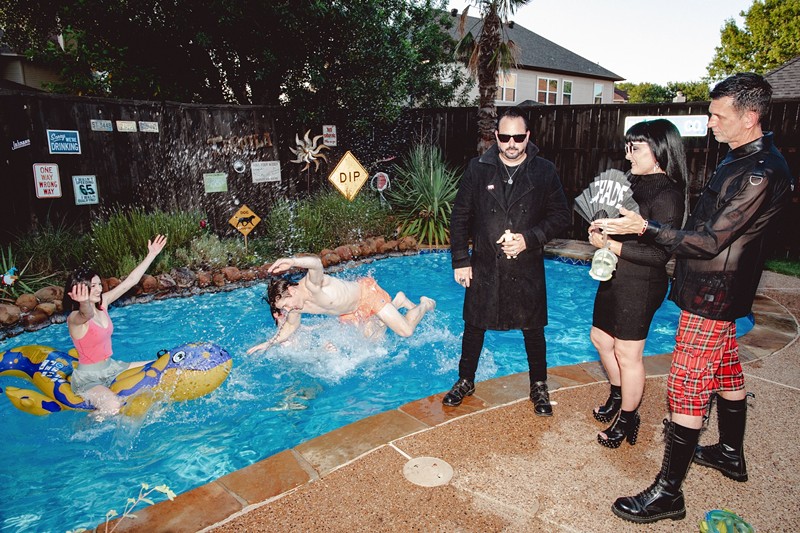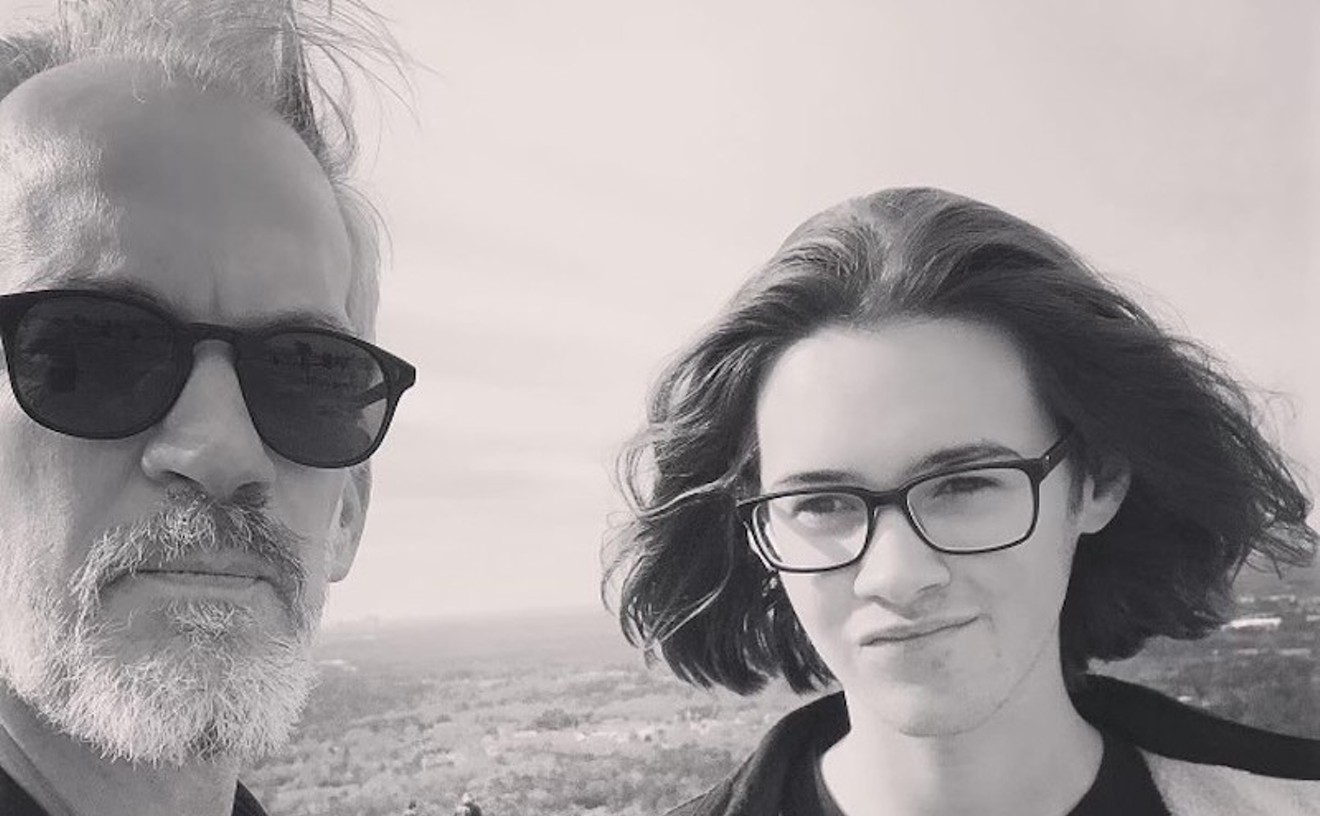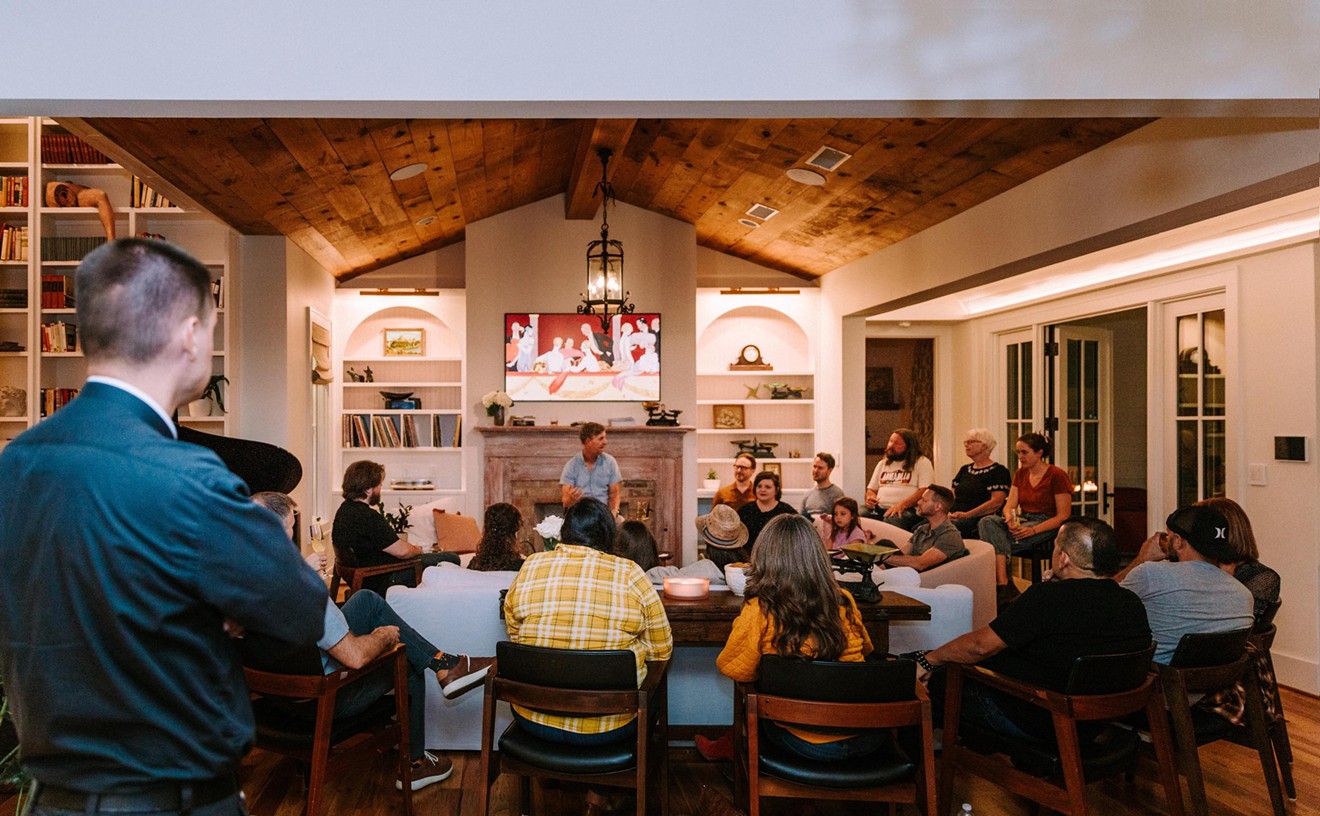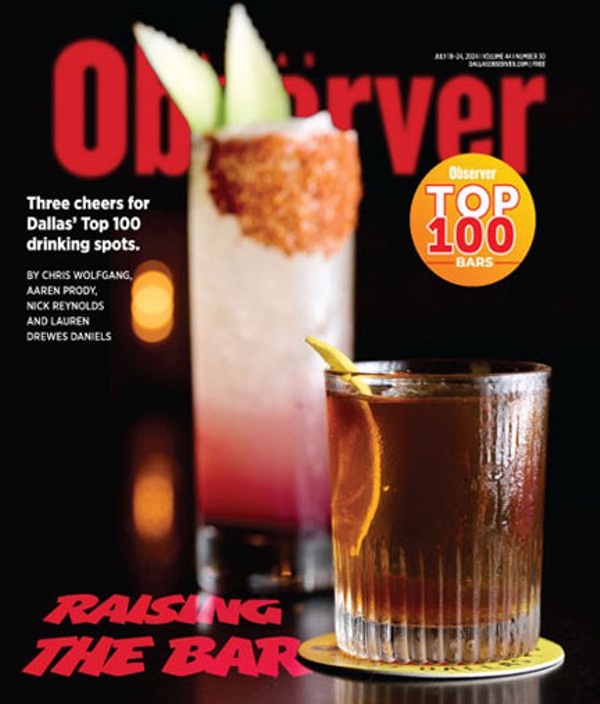“It might be time to state the obvious: It’s fucking hot, isn’t it?” Smith said before the first of two encores.
It was obvious. At an outdoor show in May, short sleeves and short shorts were our ticket to surviving. But when we looked around, it seemed like no one else who got the memo.
Trench coats instead of tanks. Corsets over crop tops. Sweat-smeared white makeup and black eyeliner into a swirl. It looked like hell — and every goth there would’ve taken that as a compliment.
It was hard not to feel bad, though. What do you do if you're a goth in the Texas heat? Would you rather let your body suffer from the heat or let your soul suffer from putting on a pair of shorts?
The scene at Dos Equis and Dallas’ brutal 2024 summer inspired us to ask North Texas goths the same question: How do you find a balance between self-expression and self-preservation?
“On those 100-degree days I do wish I could dress up fully but I don’t want to be constantly sweating and dying just for a cool fit,” says self-described goth Vivian Verne.
Verne’s arms are peppered with sleek tattoos, always on display at her job as a tattoo artist. Her hair is jet black, fit for dark-inspired modeling she does on the side. She knows her look and sticks to it. But she knows Texas, too, so she’s learned to adapt
“The heat in Texas definitely makes it difficult to wear what I want,” she says. “I’ve had to cut down on how many layers I can wear when I go out and wear skirts rather than pants to keep cool. Luckily there are ways to appear fully dressed up without wearing too much. I’ve bought a lot of light clothing that I can still layer and accessorize. Things like lace skirts, crop tops or lace tank tops, shawls and kimonos are my go to for the hotter weather, though there are days when I will settle for black shorts and a t-shirt.”
Maddie Fritz can’t compromise so easily. She plays bass in the goth four-piece Sevit, with her hair standing nearly three inches tall and her outfits drawing her an orbit of eyes.
“I get it down to about an hour and a half if I’m lucky,” she says. “But it’s taken me over two hours at some points.”
Fritz describes her style as glam goth, mixing elements of traditional goth fashion with the dazzle of ‘80s stars like David Bowie. It’s an ambitious combination, and she’s refined her process down to a science.
“First I crimp my hair, and as I’m crimping my hair I’ll hairspray it,” Fritz says. “Then I’ll start teasing it up strand by strand. I usually do it the night before a show and sleep on it, then tease it back up the next day. It can last anywhere between three to five days, but some people do wear their bat’s nest for about a week.”
Sevit was founded by keyboardist Cameron Brand, who’s been creating goth projects in Dallas for decades.
“My wardrobe has always been consistent,” Brand says. “I usually wear a long black coat. Everything’s always been black with me, black jeans, black shirts. I hate putting on the makeup, it’s a chore. I usually put on the white face and heavy eyeliner when I’m feeling really spooky. When people see me they’re like, ‘That’s Cameron.’”
It’s certainly Cameron, but it’s certainly hot too.
“I hate summer,” Brand says. “I feel like I’m gonna be set on fire.”
The physical Texas climate is the main obstacle here, but the social climate is another. Goths in Texas are used to the stares.
“I don’t mind when people look at me weird,” Fritz says. “I’m pumping my gas while my hair is all teased up and people are looking at me like, ‘What is she doing? It’s not Halloween.’”
Lilith LaVey took a little longer to get comfortable with the attention. She’s a recurring character in the DFW goth nightlife, where she goes by “Kinkerbelle.” She goes out in bikinis, fishnets and corsets, taking time to acclimate to the attention.
“It was tough to get used to because there’s a lot of people who will still look at you sideways in public,” says LaVey. “You have to know that eyes are on you and you have to be OK with that.”
The stares are just one thing for LaVey. She’s dealt with a number of hostile interactions related to her appearance.
“Sometimes they’ll specifically target you because they know you have certain political views,” she says. “People telling me to find God, people telling me that they’ll rape me straight.”
LaVey remains undeterred and frequents Dallas' most popular goth institutions: Panoptikon and The Church. She takes a more liberal approach to goth fashion in the heat, wearing more conventional hot-weather attire with a dark angle to it.
“For the past few months and for the next few months after, it’s gonna be a lot of bikinis, thin, breathable corsets, fishnets and lacy mesh stuff,” LaVey says. “It’s too hot to have to be wearing, like, actual clothes.”
The Church is a goth-themed DJ night that’s been held at various venues for over 30 years. Earlier this year, a documentary about its storied past premiered at the Dallas International Film Festival, titled Dark Sanctuary.
PANOPTIKON is the second home for Dallas goths. It’s an event currently hosted at Sons of Hermann Hall, presented by a rotating lineup of DJs including Byron Laszlo, who goes by Lord Byron.
The Scene in Dallas
Being in the scene for so long, Laszlo is privy to most goth’s personal politics.“I’m married to a guy. There’s only two parties, and there’s one that absolutely doesn’t want the best for me,” he says. “It’s hard for me to look at someone and not think these things when I know how they’re voting. It feels like they’re voting against me.”
For Laszlo, balancing the political climate as a host proves to be just as important as the physical one.
“I have to put that aside in the space,” Laszlo says. “Even if we don’t see eye-to-eye, there is this commonality between us. I just want to have a safe, welcoming space in the alternative community.”
As an attendee, LaVey noticed the same thing.
“I accept that Texas is a red state and probably always will be, but the backbone of alternative subcultures has always been political,” she says. “People coming into these spaces and not realizing that is ridiculous.”
It’s true that alternative subcultures are rooted in politics most of the time, but the exact origin of goth isn’t linear.
In the 12th century, gargoyles overlooked buildings with dark stained glass and sharp pointed peaks. Goth had a look. In the 1960s, Screamin’ Jay Hawkins began his performances by rising out of a casket and brandishing a skull on the tip of his cane, ushering in the first wave of traditional goth iconography. Goth had a feeling. In 1979, British rock band Bauhaus wrote the vampiric “Bela Lugosi’s Dead,” their dark 9-minute magnum opus that inspired countless bands to come. Goth had a sound. At the time, it was called post-punk. Now, it’s seen as the beginning of its own sub-genre spanning over 40 years.
That makes three origin stories to choose from, and none of them are political.
But in the 16th century, Italian painter Giorgio Vasari famously described Gothic architecture as “barbaric,” leading to the style being generally discontinued and at times destroyed. Even though Hawkins’ “I Put A Spell On You” became a sensation, he was never taken seriously as a vocalist compared to his peers. The campiness that made him famous was pushed too far, with songs such as “Constipation Blues” in 1969 turning him into a schlocky horror sideshow.
After Bauhaus inspired traditional goth music and fashion, goths became the target of the "Satanic Panic" in the late ‘80s and ‘90s. In 1999, Columbine High School shooters Eric Harris and Dylan Klebold were labeled as goth, launching an onslaught of anti-goth sentiment in tabloids and churches.
Nine centuries from the first glimpse of goth culture, it seems that general society has still never truly understood it.
When something goes against the grain in America, there are only two outcomes: criticism or commercialization. Goths had been criticized enough, but when the negative sentiment reached its peak, a business opportunity emerged.
By way of nihilistic lyrics, black clothes and heavy white makeup, Marilyn Manson became the face of goth culture by the late ‘90s. His ascension seemed to bastardize the culture, cherry-picking its most sensational elements in order to shock his way to prominence. To some, the ease of becoming a commercialized periphery of goth culture cheapened the essence of what the movement was supposed to be.
“I see the crowds at PANOPTIKON adjust with wearing less and lighter clothes,” Laszlo says. “Fishnets are a staple for everyone year-round as well as good hair and makeup. As far as the clubs and bars go, you gotta have good AC, especially when it’s almost 100 degrees at 9 p.m.”
His own wardrobe reflects that too.
“I love vinyl pants, I could wear them every day,” Laszlo says. “To be a little more comfortable in Texas summer months, I like well-fitted cargo or plaid shorts, usually with a band t-shirt or hoodie. I like to accessorize with leather cuffs or wear bracelets on my wrists”
Laszlo’s night at PANOPTIKON is marketed toward the old-school goth, spinning loads of Siouxsie and the Banshees, The Sisters of Mercy and Bauhaus. That initial wave of dark ‘80s music laid the blueprint for the aesthetics of modern goth culture. To some, the commercialized peripheries of being a goth cheapened the true essence of what the movement used to be.
“Real goths don’t call themselves goth,” says Krystal Garcia, who moderates multiple DFW goth Facebook groups and helps to promote local goth bands. “Ninety percent of my closet is black, yes, but to me that just looks better on anybody.”
Garcia started attending goth clubs in the late ‘90s. She jumped into the scene hoping to acquaint herself with the local goth music scene, but the clubs weren’t what she expected.
“I noticed there was a clear distinction between people who would just go to the club and people who would actually go to see live music,” she says. “There’s a lot of people that just go because they like the clothes. It would get frustrating when you would see so many good bands come through that didn’t get the attention they deserved.”
Crashing In
Jay Gavit is trying to get local goth bands the attention they deserve. Known as DJ Crash, he spins records on The Catacombs on 89.3 KNON from midnight to 4 a.m. on Saturdays. The show was pitched as the audio after party for goths to tune into on their way home from PANOPTIKON.With the midnight – 4 a.m. show time, Gavit has to be a night owl. But being a goth in Texas, he didn’t need any sort of transition.
“We joke about the fact that we’re vampires,” he says. “Crowds usually don’t really show up to our things until 11. Why is that? Summer in Texas is extreme, but the nights are nice. It’s cooler to go outside, so we just adjust to be more night people.”
Some nights can still get up to high 80s, but that won’t curb Gavit.
“Everything’s black,” he says. “You still adjust a little bit. Not so heavy on layers. Not wearing gloves, not wearing jewelry. But you will never see goths wearing pastel shorts like groups of SMU [Southern Methodist University] jocks.”
We attended a live broadcast of The Catacombs with Gavit at the helm and LeVey joining as a guest. Even on an audio-only show, the crew came dressed for an evil fashion runway. Gavit wore heavy eye shadow and red makeup that looked like burns on his face, with a black mop of hair that flopped with each turn. LeVey stopped by straight from PANOPTIKON, sporting three layers of black regalia complete with a hot pink Hello Kitty fanny pack. The crew was completed by Gavit’s regular co-host, Lily Lurid, and socialite Star Daniels, both dressed equally dark.
When the midnight hour hit, Gavit turned off the overhead lights in the KNON studio and turned on a set of strobing lasers that zig-zagged around the room all night as he DJed. The five of us had entered our own mini goth club where we swapped ghost stories around a campfire between songs, except the club was an office room and the campfire was a set of LEDs.
There’s an irreverence to the goth that many of us grew to love that night. I entered their territory wearing a baby blue T-shirt and, don’t tell them this, I don’t really care for “Bela Lugosi’s Dead.” So what? I was welcomed and stayed till 4 a.m. when, ironically, a gospel show takes over the studio.
Dallas has projected highs of 95–98 degrees next week. So what? We know how Maddie Fritz and Cameron Brand are going to dress in July at the Cicada in Fort Worth. We know the way Lillith LaVey is going to dance when Byron Laszlo queues up another track at Sons of Hermann Hall. We know they’re all going to tune in to The Catacombs hot and sweaty, but happy, because they’re living the life they know they want to live.
“The world is gonna come to a fiery end,” Gavit says. “Let’s dance, and look good doing it.”











